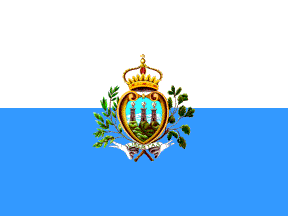 (3:4)
(3:4)
image by Mark Sensen, 16 April 1998

Last modified: 2006-01-21 by dov gutterman
Keywords: san marino | europe |
Links: FOTW homepage |
search |
disclaimer and copyright |
write us |
mirrors
 (3:4)
(3:4)
image by Mark Sensen, 16 April 1998
Official Name: Republic of San Marino
(Repubblica di San Marino)
Capital: San Marino
Location: Southern Europe - Enclave in Central
Italy
Government Type: Republic
Flag adopted: 6
April 1862
ISO Code: SM
See also:
I got the my following queries about San Marino:
-According to some Internet-sources the official designation of
San Marino between 301 and 1243 was successively "Land of
San Marino" and "free City of San
Marino". Can you give me the long-form names in local
language and the exact dates/years of the use of these names?
- After 1243 San Marino was officially styled as: "Most
Serene Republic of San Marino", according to most historical
documents (for instance: de Political Handbook of the
World). But the coins of San Marino just mentioned
"Repubblica di San Marino". Does this mean, that
both names are equally used as official names for the polity. Or
does it means that "Repubblica di San Marino" was used
later on (can you give me the exact date) besides or in
stead of the "Most Serene Rep. of San Marino". Or was
the term used only in semi-official usage?
- Did the formal names and the styles of San Marino
changed (for instance: duchy or county) during the following
foreign occupations:
-1503 Ceasar Borgia
-1739/40 Papal State
-1944 Germany
-1944 Britain and USA
Henk Meyer, 27 December 2000
Land of San Marino: Terra di San Marino.
Free City of San Marino: Cittá Libera di San Marino.
I think that the "Most Serene Republic of San Marino"
is just a grand title. As far as I know, San Marino has always
been Republic of San Marino, at least since 1815.
Gerhard Eger, 8 January 2003
The actual denomination is "Serenissima Repubblica di San
Marino", where "Serenissima" is the Italian for
"The most serene" (better, in this case it means
"The very serene"); the adjective has been
historically used for the Republic of Venice, in facts "La
Serenissima" in Italy is used to indicate Venice or its old
Republic.
Alberto Fiorentini, 12 May 2003
No official shades have been issued with regard to either the
stripes or the arms, and no recommendations for the arms are
given in any official source. However, the UK Flag
Institute give Process Blue, BR20 PMS 549 and the Album des
Pavillons PMS 292C for the stripe.
Christopher Southworth, 4 Maech 2005
As stated in W.Smith's "F&AATW" by government
and army forces is used the white-blue flag with state's coat of
arms. As I read the signs there is a few variants of the
appearance of the arms. Also it is stated that the flag is a 'de
facto' flag, used without the legal background.
Željko Heimer, 10 November 1995
In Derkwillem Visser's "Vlaggen van de Wereld"
("Flags of the world") he mentions the flag was
officially adopted on 6 April 1862.
Mark Sensen, 10 November 1995
In Znamierowski's book [zna99]
there is a mistake at p. 154: San Marino: the state flag is with
the arms, not the national flag
Marcus Schmoger, 16 July 2000
According to Album 2000 [pay00]
- National Flag (CSW/--- (3:4)) - White over blue bicolour with
the coat of arms in the middle. Can we confirm and provide more
details on the adoption date 6 April 1862 (given also by Smith
e.g. 1982) ?
The October 1917 National Geographic [geo17]
show (figure 816) the Ensign as blue over white with Coat of Arms
in the middle. Is this simply and error? Is there any other
source showing blue over white flag for SM?
Album 1995 Recapitulative 1 shows only the flag with Coat of Arms
(not the same artistic representation as in 2000) captioned as
National Flag (3:4).
Flaggenbuch 1939 shows three images as in Album 2000 (of course,
different artistic representation of the Coat of Arms, but minor
differences).
Željko Heimer, 2 January 2003
Who changed San Marino's flag? In three books I found the image, but modern flag-books
depict it as the present one. The last one, to have the 'old'
flag is Barraclough's FOTW (1971). The change is in the Coat of
Arms.
Sources: 'Old' SM-flag: 'Vlaggen, Drapeaux, Flags, Die
Flaggen', 1951
'Observer's Book of Flags', I. O. Evans, 1959
'Flags of the World', Barraclough, 1971
'New' SM-flag: 'dtv-Lexikon politischer Symbole', A. Rabbow, 1970
'Flags Through the Ages and Across the World, W Smith, 1975
'Moussault's lexicon van vlaggen en wapens', Pedersen, 1980
(&c) Etcetera
Jarig Bakker, 26 May 1999
If it is only regarding the stylization of the Coat of Arms on
the flag - this can hardly be called a change.
Željko Heimer, 2 January 2003
The flag was formally adopted by a Decree of the Supreme
Council of 6 April 1862, following San Marino's treaty with the
new Italian Kingdom (almost certainly also of 1862 but exact date
unknown). Although I do not have a copy of this
particular item, I further understand that the flag
was officially regulated (including de jure
proportions of 3:4) by 'Stemma, Bandiera, Sigilli
e Uniforme' issued as an Act of the 'Corpo Consolate'
dated 12 January 1892 (?). As far as the construction details are
concerned, an (unfortunately undated) official model of the State
Flag I have on file, shows the arms as being one-third of the
length of the flag wide, and four-ninths of its width in height,
however, this model is in proportions of 4:5 which is apparently
an incorrect ratio (?).
Christopher Southworth, 10 September 2004
 (3:4)
(3:4)
image by Mark Sensen, 7 November 1995
According to Album 2000 [pay00]
- this is the alternative civil flag (C--/C-- (3:4)). Regarding
the civil flag (and ensign), has anyone ever seen a ship (boat,
yacht whatever) registered in San Marino? Was this flag confirmed
in use on sea in modern time?
Ivan Sache, 14 January 2001 and Željko Heimer,
2 January 2003
My name is Martin Grund from Germany. I am the initiator of
the world's first penguin webcam in the Antarctic. At the moment
there is a scientist from San Marino working in the German
Antarctic Research Station Bernado O'Higgins and you can see the
civil flag of San Marino in the photo of one of the station's
webcams. Here a photo from
our archive at <www.pinguincam-online.de>.
Martin Grund, 29 November 2004

image by Rick Wyatt, 6 September 1998
The flag you mention has been reported as the Merchant Ensign
of San Marino by various sources (see National Geographic for
example). Unfortunately no evidence exists that this flag
actually existed. San Marino, for those who did not have a chance
to visit it, is on a mountain with no direct access to any sea,
even if the Adriatic Sea is close to it.
Pier Paolo Lugli, 6 april 1998
The October 1917 National Geographic [geo17] states: Figure 815: "The
merchant flag of San Marino, which, though that of a belligerent,
the little republic having dared to declare war against the
Central Powers, has probably never yet been encountered by a
German submarine because, as may well be imagined, the merchant
navy of the mountain republic is not large."
Nick Artimovich, 6 April 1998
The Declaration of Barcelona, 20th April 1921 recognised the
right of states with no littoral to fly their own flag at sea.
D.Prothero, 6 October 2000
Description
Description in Pedersen's "Moussault's Lexicon Vlaggen en
Wapens", 1980: "In its present the CoA dates from 6 Apr
1862. Even though San Marino was always a republic, it has a
crown on top of it as a sign of sovereignty. The three white
towers, crowned by a ostrich feather, remind of three castles on
three mountain tops of the Titano Mountains. The CoA dates at
least from the 14th century. Around is wreath of oak and laurel.
Motto: Libertas - Liberty."
Jarig Bakker, 3 January 2003
The Crown
Nathan Lamm asked: If it's a republic, why is there a
crown on the seal?
This is surely among the oldest republics to do so, but a number
of other republics in the region did (and some still do) the
same. The crown is here symbol of sovereignity and independence
rather then the hereditary monarchy. Some examples that come to
mind include Republic of Ragusa (Dubrovnik, on this side of
Adriatic), and in modern age both Austrian republic(s) and even
more modern Hungarian republic use crowns as symbols of
sovereignity. Poland comes to mind, too.
Željko Heimer, 3 January 2003
The Towers
Nathan Lamm asked: What are the smokestacks, if
that's what they are?
These are three towers, each with an ostrich fether on the top.
These picture the towers of the citadel of San Marino named
Guaita, Cesta and Montale. Each of the towers is, they say,
equiped with a metal wane at the top, that is in heraldic
interpretation pictured as feather. Compare, e.g. Smith 1982.
Željko Heimer, 3 January 2003
The Branches
Nathan Lamm asked: What are the two different
branches on the sides?
I guess that I can't be that wrong interpreting the branches as
laurel and oak. These are usualy taken to symbolize glory and
(military) strength, and as such found in many Coat of Arms (cf.
Portugaese army emblem, Estonian greater arms etc.).
Željko Heimer, 3 January 2003
The IXth Small States Games shall take place (or already took
place) in 2001. Since San Marino does not miss any opportunity to
release post stamps, this sport event was celebrated by the
release of a leaf of nine stamps. The top and bottom of the leaf
are decorated with the arms of San Marino and a logo which could
be the one of San Marino National Olympic Committee (the
black-and-white image in my stamp catalogue is too small to see
anything but the Olympic rings).
Ivan Sache, 25 August 2001
You can see them at <www.aasfn.sm>.
I suppose it is SM Olympic Comittee logo and I guess that it may
appear on white flag as SMOC flag.
Dov Gutterman, 25 August 2001